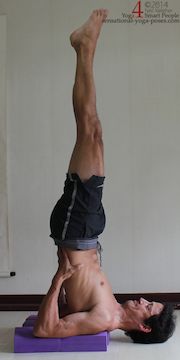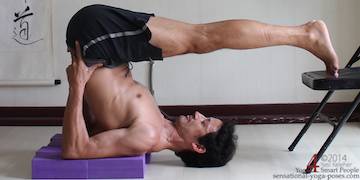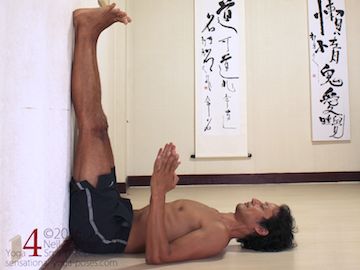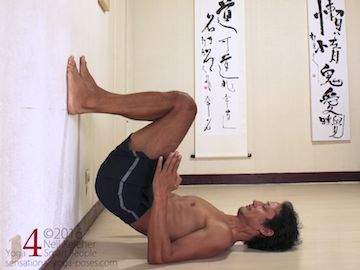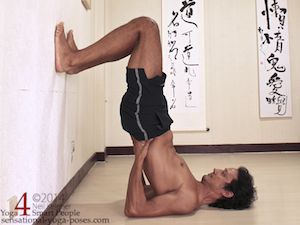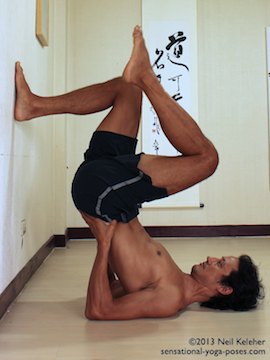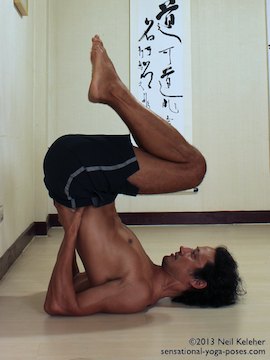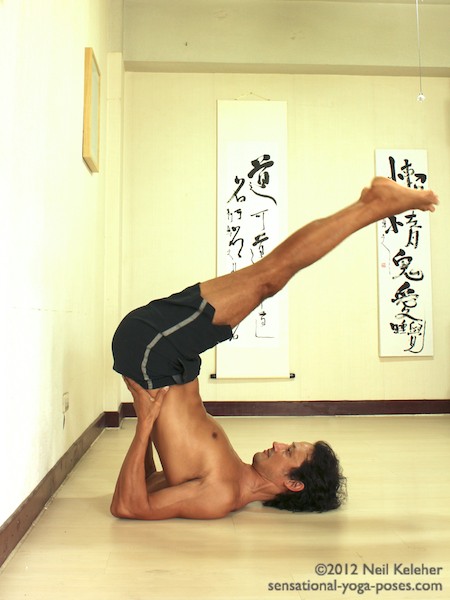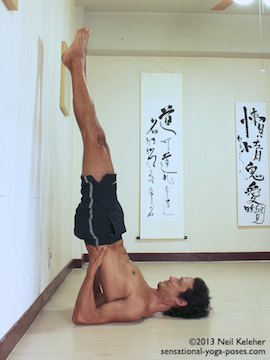Using A Wall for Back Pain
I also use shoulderstand for one of my yoga clients who has a back pain.
Doing shoulderstand using a wall he can better control his lower body both going into the pose and getting out of the pose. With his feet on the wall I have him focus on using his buttocks to press his hips away from the wall.
I also make sure that once his feet leave the wall, the first thing he practices is getting his feet back onto the wall.
This is easiest (and pain free) if he scissors his legs for balance. He can then slowly touch one leg to the wall. Once one foot is on the wall, he can activate the butt muscle of that leg to stabilize his lower body. He can then slowly bring the other foot to the wall and then use the muscle power of both legs to slowly lower his butt to the floor.
Shoulderstand as a Restorative Yoga Pose
I also like to use the wall to get into shoulderstand if I'm tired and want a more restorative yoga practice. Usually I might start of with my butt against the wall and my legs up the wall (viparita karani) and then from there I move into shoulderstand. Then from shoulderstand I might do shoulderstand splits with one foot on the floor behind me and the other foot on the wall.
From there it is relatively easy to move into plow pose.
After doing shoulderstand I can then go back into viparita karani and then from there do hip stretches using the wall.
Usually, even if I am tired when I started, I find that using the wall for support I feel refreshed enough afterwards to do regular yoga poses or stretches.
Shoulderstand Using Blankets?
Shoulderstand using a wall (or not) is an inverted yoga pose where the backs of your shoulders, upper arms and back of the head are all on the floor with the weight of the body either between the elbows and the shoulders, over the shoulders or over a point between the shoulders and the back of the head.
Ideally the torso and legs are vertical to begin with I often do this pose with the torso incline slightly away from my head and my legs inclined upwards and towards my head. I then gradually work at making my chest and legs more vertical.
Another option which reduces the forward bend of the neck is to do shoulderstand with the shoulders and elbows on some blankets so that the head can hang towards the floor. This takes a lot of the stress off of the neck. It can also be done with yoga blocks if you have enough of them.
This method is particularly helpful if you like to do long holds.
(Upwards of 5 minutes or more.)
Steps for Shoulderstand Using a Wall
When doing shoulderstand using a wall, the first step is to lay with your feet up a wall. Move your body close enough that your butt touches the wall.
Bend your knees. Press your feet into the wall to lift your pelvis off of the floor. As you lift your pelvis higher you may need to walk your feet up the wall.
Slowly push your pelvis away from the wall until your can get your hands up to your lower back. From there wiggle from side to side so that you can get your shoulder blades towards each other.
Note that you can simply hold this final position, with feet against the wall. In this actual version of shoulderstand using a wall, as you get more comfortable you can play with using your feet to move your pelvis closer to the wall and further away from it.
Retract Your Shoulder Shoulder Blades
When you move your shoulder blades towards each other they help to move the top of the ribcage (and the base of the neck) away from the floor. The idea here is that the shoulder blades for your base, and not the knobbly bits of your spine (the spinous processes.)
(To help you retract your shoulder blades you can try these scapular awareness exercises. You may also find this shoulder stretch helpful.)
From there use your legs to slowly push your pelvis away from the wall to the point that your pelvis and ribcage are over your shoulders.
Pay attention to your neck. If your neck tells you to stop, then stop.
If you can't get your ribcage vertical (hips over your shoulders) don't worry.
The main benefit from this pose may be from being upside down. While being perfectly vertical looks cool, it isn't a necessity.
(And you can work towards it gradually.)
Just being upside down, can have a restorative affect. How do you know if it is having a restorative affect? Ideall you feel good or refreshed after doing this pose. And that will probably only happen if your neck is comfortable.
So if you find your neck is uncomfortable, then move your hips only a little bit away from the wall.
Support your hips with your hands, and then scissor your legs so that you move one leg away from the wall. Move it far enough away from the wall that pressure of your elbows pressing into the floor is reduced. You may also notice the back of your head pressing down.
From there bring your other leg away from the wall slowly. Pay attention to your foundation. As you bring the second leg back you'll have to bring the first leg towards the wall slightly. Try to do it in such a way that your elbows, shoulders and head continue to press down in the same way.
Once your legs are together, you can shift your weight forwards or back as you prefer.
Another option for bringing the legs away from the wall is to keep both knees bent. Move one knee back and down towards your chest. Then move the other knee back so that your knees are together.
Then slowly straighten your knees. You can hold the position shown below.
Or you can move gradually towards the position shown below.
Notice your neck, and as your neck gets more comfortable you can try moving your hips further away from the wall. At the same time move your legs towards the wall so that you stay balanced.
Notice Your Weight
As you get more comfortable doing shoulderstand, notice the way your weight presses down through your elbows, shoulders and the back of your head.
- If you move your weight towards the wall you'll probably find that your elbows press down more.
- If you center your weight over your shoulders then you'll probably find less weight pressing through your elbows and less strain on your neck.
- If you move your hips towards your head, then you'll tip back more and you'll probably find you'll get a lot more stretching in your neck. You try to deliberatley bend your neck backwards to engage the muscles at the back of your neck.
Engage the Back of Your Neck or Relax It?
For a really stable shoulderstand you can experiment with engaging the muscles of the back of your neck so that your neck tries to straighten. You'll then be using your head and neck like a jack that you use to lift your body up. In this case you may find that your shoulders lift up slightly and you'll be balancing on your elbows and the back of your head.
Otherwise, keep the back of your neck relaxed, pull your chin to your chest and gradually shift your weight towards your head to gradually lengthen the back of your neck. Or keep your weight over your shoulders so that you leave your neck more or less alone.
Move Shoulder Blades Towards Each Other
To avoid your the spinous process/nobby bits of your cervical and thoracic vertebrae from pressing into the floor, move your shoulder blades towards each other. To make this easier, move them towards the head at the same time.
You can grab your hands behind your back to help wiggle them together, or grab a towel or hold on to the edges of your mat with both hands and then wiggle them together.
Then put your hands back at your lower back.
Coming Out of Shoulderstand Using a Wall
Note that to come out of shoulderstand using a wall it may be painful it you just roll out since you'll crash into the wall. So come out the same way you went it, one leg at a time. Once you get one leg against the wall, push it into the wall to support your pelvis. Then move your other foot to the wall. Then use both feet to lower yourself down.
Afterwards you may want to reactivate the muscles at the back of the neck. As so you could use locust pose as a counterpose.
An option for getting into shoulderstand or salamba sarvangasana without using wall is to roll into it. And for more on using a wall you can read yoga poses using a wall.
Published: 2011 07 18
Updated: 2021 02 09

